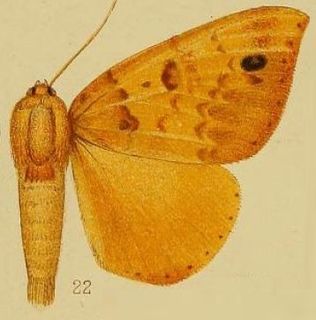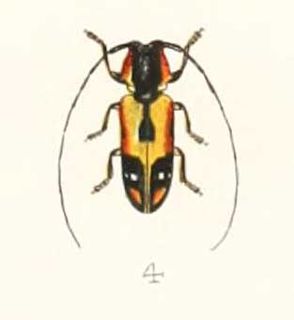
The Mutillidae are a family of more than 7,000 species of wasps whose wingless females resemble large, hairy ants. Their common name velvet ant refers to their dense pile of hair, which most often is bright scarlet or orange, but may also be black, white, silver, or gold. Their bright colors serve as aposematic signals. They are known for their extremely painful stings,, hence the common name cow killer or cow ant. However, mutillids are not aggressive and sting only in defense. In addition, the actual toxicity of their venom is much lower than that of honey bees or harvester ants. Unlike true ants, they are solitary, and lack complex social systems.

Pentatomidae is a family of insects belonging to the order Hemiptera, generally called shield bugs or stink bugs. Pentatomidae is the largest family in the superfamily Pentatomoidea, and contains around 900 genera and over 4700 species. As hemipterans, the pentatomids have piercing sucking mouthparts, and most are phytophagous, including several species which are severe pests on agricultural crops. However, some species, particularly in the subfamily Asopinae, are predatory and may be considered beneficial.

The conservation status of a group of organisms indicates whether the group still exists and how likely the group is to become extinct in the near future. Many factors are taken into account when assessing conservation status: not simply the number of individuals remaining, but the overall increase or decrease in the population over time, breeding success rates, and known threats. Various systems of conservation status exist and are in use at international, multi-country, national and local levels as well as for consumer use.

Scutelleridae is a family of true bugs. They are commonly known as jewel bugs or metallic shield bugs due to their often brilliant coloration. They are also known as shield-backed bugs due to the enlargement of the thoracic scutellum into a continuous shield over the abdomen and wings. This latter characteristic distinguishes them from most other families within Heteroptera, and may lead to misidentification as a beetle rather than a bug. These insects feed on plant juices from a variety of different species, including some commercial crops. Closely related to stink bugs, they may also produce an offensive odour when disturbed. There are around 450 species worldwide.

Johann Christoph Friedrich Klug, was a German entomologist. He described the butterflies and some other insects of Upper Egypt and Arabia in Christian Gottfried Ehrenberg and Wilhelm Friedrich Hemprich's Symbolæ Physicæ. He was professor of medicine and entomology in the University of Berlin where he curated the insect collections from 1810 to 1856. At the same time he directed the Botanic Garden in Berlin which contains his collections. Klug worked mainly on Hymenoptera and Coleoptera. The plant genus Klugia was named in his honour as well as the butterflies Geitoneura klugii and Heliophisma klugii.

Euploea klugii, the brown king crow or king crow, is a butterfly found in India and Southeast Asia that belongs to the crows and tigers, that is, the danaid group of the brush-footed butterflies family. The species was first described by Frederic Moore in 1858.
Oreopanax klugii is a species of plant in the family Araliaceae. It is endemic to Peru.

Parinari is a genus of plant in the family Chrysobalanaceae.

Heliophisma is a genus of moths of the family Noctuidae.

Heliophisma catocalina is a species of moth of the family Noctuidae first described by William Jacob Holland in 1894. It is found in Gabon, Ghana, Tanzania and Nigeria.

Heliophisma xanthoptera is a species of moth of the family Erebidae first described by George Hampson in 1910. It is found in Kenya, Mozambique, Tanzania Sierra Leone, South Africa and Zambia.

Hemilepistus is a genus of woodlice, created by G. H. A. Budde-Lund in 1879 as a subgenus of Porcellio, but raised to the rank of genus by Karl Wilhelm Verhoeff in 1930. It contains the following species:
Dexithea is a genus of beetles in the family Cerambycidae, containing the following species:

Armadillidium klugii is a lesser-known, rare Balkan, Dalmatia-based species of woodlouse, most distinguished by its colouration which resembles the red markings of the Mediterranean black widow Latrodectus tredecimguttatus. This is probably a kind of mimicry, to ward off predators that mistake the harmless animal for a venomous spider.

Glomeris klugii is a species of pill millipedes.
Tyrinthia klugii is a species of beetle in the family Cerambycidae. It was described by James Thomson in 1868. It is known from Colombia.

Tragocephala mniszechii is a species of beetle in the family Cerambycidae. It was described by James Thomson in 1857. It has a wide distribution in Africa.

Aelia is a genus of shield bug belonging to the family Pentatomidae.

Pachycoris is a genus of true bugs in the family Scutelleridae, subfamily Pachycorinae. The adults often have large bright spots. It was described by Charles Jean-Baptiste Amyot and Jean Guillaume Audinet-Serville in 1843.















